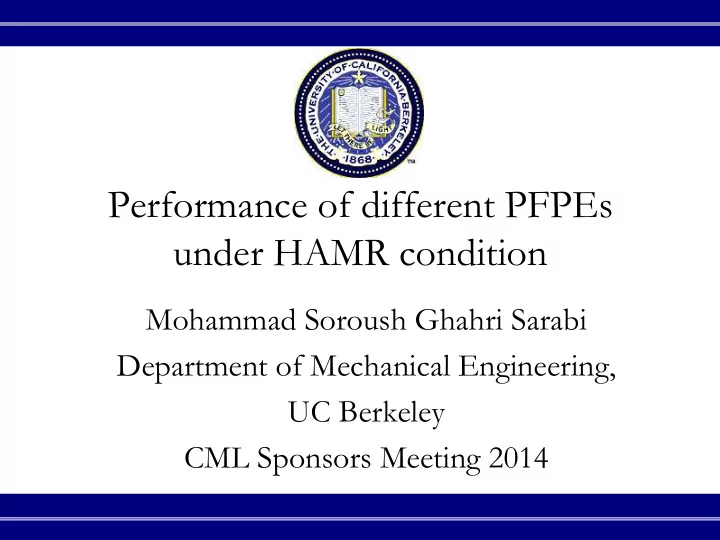

Performance of different PFPEs under HAMR condition Mohammad Soroush Ghahri Sarabi Department of Mechanical Engineering, UC Berkeley CML Sponsors Meeting 2014
Outline n Governing Equation and Problem definition n Specifications of Z-tetraol 2200 n Simulation Results n Conclusion n Future Study Soroush Sarabi & David B. Bogy January 2014 Computer Mechanics Laboratory
Problem Definition Disjoining and Laplace n pressure gradients work as restoring force Evaporation is affected by n disjoining pressure Parameter Value FWHM 20 nm T max 350 C U D 5 m/s Lube 0.5, 0.7, 1.2, thickness 1.4 nm Ts 2ns Soroush Sarabi & David B. Bogy January 2014 Computer Mechanics Laboratory From Joanna Dahl’s Thesis
Z-tetraol Disjoining Pressure Z-dol has steeper curves compared to Z-tetraol n So, Disjoining pressure derivative for Z-tetraol is less compared to the one for Z-dol n Therefore, disjoining pressure gradients for Z-tetraol are weaker than the one for Z-dol n This means less restoring force n However, the absolute value of disjoining pressure is more for Z-tetraol and therefore we n expect less evaporation Soroush Sarabi & David B. Bogy January 2014 Computer Mechanics Laboratory
Z-tetraol Viscosity Bulk viscosity of Z-tetraol is higher than Z-dol n specially near room temperature For Film viscosity model we use Eyring’s rate n theory that Karis uses as follows: µ E E Δ = Δ − vis vis , ∞ n Where: n For Z-dol: n µ = − AV l E vis 34 . 7 KJ / mol Δ , = ∞ 6 π h 3 For Z-tetraol: n AV l µ = − E vis 50 . 8 KJ / mol Δ , = 12 π ( h + d 0 ) 3 ∞ Soroush Sarabi & David B. Bogy January 2014 Computer Mechanics Laboratory
Results: Flow Under HAMR Condition n Z-tetraol has smaller deformations compared to Z-dol Soroush Sarabi & David B. Bogy January 2014 Computer Mechanics Laboratory
Results: Lubricant Recovery n Two cases were studied, 1.2 and 1.4 nm initial lube thickness n There is a significant difference between recovery time of Z-tetraol compared to Z-dol, Almost a factor of 200 Recovery 1.2 nm 1.4 nm Time Initial Initial Thickness Thickness Z-dol 10.2 µ s 28.2 µ s Z-tetraol 2.0 ms 5.0 ms Soroush Sarabi & David B. Bogy January 2014 Computer Mechanics Laboratory
Results: Evaporation Z-tetraol has less lubricant evaporation compared to Z-dol n This behavior is expected because Z-tetraol has higher disjoining pressure n Soroush Sarabi & David B. Bogy January 2014 Computer Mechanics Laboratory
Conclusion n Under HAMR condition Z-tetraol exhibits less deformation, smaller trough and side ridges. This is expected because of higher viscosity and lower fluid mobility of Z-tetraol compared to Z-dol n Z-tetraol needs more time to recovery compared to Z- dol. This was expected because of less mobility of Z- tetraol and also weaker restoring forces (i.e. disjoining and Laplace pressure gradient) n Z-tetraol has less evaporation compared to Z-dol due to stronger disjoining pressure in Z-tetraol Soroush Sarabi & David B. Bogy January 2014 Computer Mechanics Laboratory
Future Study n Study the behavior of Z-tetraol for various laser spot sizes and maximum temperatures n Study the behavior of Multidentate functionalized lubricants (e.g. ZTMD) n Add the viscoelastic terms to our model in order to obtain a more accurate result n Study the effect of viscoelastic terms in behavior of fluid n Determine effective IMF constants for ABS modeling in presence of HAMR lubricant Soroush Sarabi & David B. Bogy January 2014 Computer Mechanics Laboratory
Recommend
More recommend